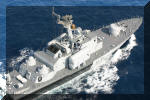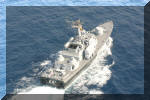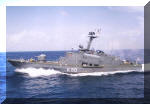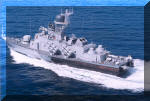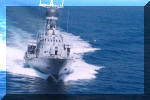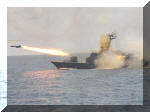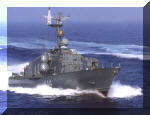Veer (Tarantul I) Class
- Details
- Category: Ships
- Published: Thursday, 26 March 1987 00:00
- Written by Corvette
- Hits: 48379
Vessel Type: Project 1241RE Missile Corvette.
Names & Pennant Numbers with Commission Dates:
INS Veer K40 (26 March 1987 at Poti, former USSR)
INS Nirbhik K41 (21 December 1987 at Poti, former USSR)
INS Nipat K42 (05 December 1988 at Poti, former USSR)
INS Nishank K43 (12 September 1989 at Poti, former USSR)
INS Nirghat K44 (15 December 1989 at Poti, former USSR)
INS Vibhuti K45 (03 June 1991 at Mazagon Dock Ltd, Mumbai)
INS Vipul K46 (16 March 1992 at Mazagon Dock Ltd, Mumbai)
INS Vinash K47 (20 November 1993 at Goa Shipyard Ltd)
INS Vidyut K48 (16 January 1995 at Goa Shipyard Ltd)
INS Nashak K83 (29 December 1996 at Mazagon Dock Ltd, Mumbai)
Note: INS Prahar K98 suffered a collision with the M V Rajiv Gandhi, a container carrier of the Shipping Corporation of India, 35 km off the coast of Goa at 9:45 p.m. on 22 April 2006. The damage to the merchant carrier was nominal, however the damage to INS Prahar led to the vessel being sunk. There was no loss of life and all personnel were safely rescued. The captain of the vessel - Lieutenant Commander Yogesh Tripathi - was dismissed from service in September 2006, after a court martial was conducted in which he confessed to committing navigational error. INS Prahar was commissioned into the Indian Navy on 01 March 1997 at Goa Shipyard Limited.
Names & Pennant Numbers with Commission Dates:
INS Prabal K92; Laid Down - 16 Feb 1998, Launched - 28 Sept 2000, Commissioned - 11 April 2002 at MDL, Mumbai.
INS Pralaya K91; Laid Down - 02 May 1998, Launched - 14 Dec 2000, Commissioned - 18 Dec 2002 at Goa SY Ltd.
Structure: Indian units were built up from plating and CKD (Completely Knocked Down) kits supplied by the Russians. Very sturdily built and surprisingly roomy, for a Russian design.
Displacement: 385 tons standard; 455 tons full load.
*Goa SY Ltd. lists 477 tons as normal displacement.
*INS Pralaya listed at 560 tons full load.
Dimensions: Length - 56.1 metres.
.................Beam - 11.5 metres.
.................Draught - 2.5 metres.
Main Machinery: M15E COGAG plant with 2 x DS71 boost gas turbines (8830 kW each) and 2 x DR76 cruise gas turbines (2900 kW each). Total output rated at 23,540 kW at ISA + 15º Celsius. Power drops to 17,420 kW at ISA + 34º Celsius.
Gearboxes: 2 x RD77 and 2 x RA76.
Electrical Capacity: 500 kW of generating capacity.
Maximum Speed: 35 - 40 knots, as per specs of Goa SY Ltd.
*INS Pralaya listed at 39 knots.
Maximum Range: 2000 miles at 20 knots.
.......................400 miles at 36 knots.
Complement: Design complement is 41 sailors (including 5 officers).
INS Prabal and INS Pralaya have a complement of 69 - 70 sailors plus 7 officers.
Radar: Air/Surface; One Garpun Bal-E (NATO: Plank Shave) radar at I-band frequency.
..........................One MR 352 Positiv-E (NATO: Cross Dome) radar fitted on K91 and K92.
.........Fire Control; Refer to 'Weapons' sub-section.
.........IFF; (NATO: Salt Pot, Square Head A).
Weapons: Four P-20M (SS-N-2D) AShMs, in two twin-tube launchers, with infra-red homing (Mod 1) to 45n miles; 83km at Mach 0.9 with a 513 kg warhead. The missile becomes a sea skimmer at the end of run. Fire control is provided by a single MR-123 (NATO: Bass Tilt) radar at H/I-band frequency. K91 and K92 carry sixteen 3M-24E (SS-N-25) AShMs with fire control being provided by a single BEL Lynx director.
One Strela-2M (SA-N-5) SAM launcher, manual aiming with infra-red homing to 3.2n miles; 6 km at Mach 1.5 with a 1.5 kg warhead. Maximum altitude is at 2500 metres (8000 feet). Possible reloads of 12 missiles.
One AK-76/60 76mm gun with 85º elevation with 120 rds/min to 8.1n miles; 15 km. In the last pair, one OTO 76mm SRGM is fitted. The CIWS comprises of two six-barrelled 30mm AK-630 gatling guns with an elevation of 85º, combined with a firepower of 3000 rounds a minute. Effective range of 2 km.
Weapons Control: Kolonka (NATO: Hood Wink) optronic director located amidships, behind mainmast.
Countermeasures: Decoys; Two PK-16 chaff launchers.
.........................ESM; One Bharat Ajanta intercept (local modification) on some units.
Comments: Veer Class corvettes form the 22 Missile Vessel Squadron, at Mumbai. The hull is made of special, lightweight, MS and aluminium alloy sheets. INS Nirghat is the successor to the illustrious Osa-I Class fast attack missile boat which rained missiles on Karachi. The new vessel has preserved the red booster covers of the original P-15M AShMs that were lobbed at Karachi in December 1971.
An order for four modified Veer Class corvettes was placed in April 1997. This four-unit order was later drawn down to two units: one at Mazagon Dock Ltd, Mumbai and the other at Goa Shipyard Ltd. INS Prabal and INS Pralaya are a further modification of the Project 12418 design and may be referred to as the Mod 1241RE in Indian Navy service. One may also hear the name Molniya for these vessels, as it is the generic Russian name for the 1241 series of raketny kater (missile cutter) boats.
INS Prabal and INS Pralaya are quite different, in equipment, armament and appearance from their sister ships. Modified with Russian input, the weapons & sensor fit is similar to that of the Project 25A Class corvette, INS Kirch. Radars include a MR 352 Positiv-E radar, a Garpun Bal E and a BEL Lynx gunfire control radar. Armament comprises sixteen 3M-24E AShMs, the BHEL-assembled OTO 76mm Super Rapid Gun Mount (SRGM) along with two AK-630M CIWS gun mounts. The Lynx fire control system controls the twin AK-630M mounts and the 76mm OTO Melara gun. The radar has the following functions: a) Detection of surface and air targets, changeover to automatic tracking mode for selected targets and establishing it's coordinates and movement parameters; b) Working out data for firing, taking into account the target manoeuvring movement, movement of boat & ballistic correction. The EW suite appears incomplete - the characteristic radome of the Ajanta system is missing.
Structurally, these vessels also have an additional deeper deck, an extended operations room, and improved habitability. These changes have resulted in an added displacement of approximately 50 tons. Said to have a 65% indigenous content. INS Pralaya has a locally-built steering gear, propulsion shafts, air compressors, a reverse osmosis (distillation) plant, minor pumps, main switch boards, distribution board for power distribution, some valves/fittings, electrical fittings, etc. INS Pralaya is estimated to cost approximately Rs.350 crores. More of this class are planned though exact numbers are unknown presently. In 1990, MDL cancelled a study to equip the Indian-built units with a General Electric LM2500 gas turbines and two MTU diesels due to technical difficulties.



